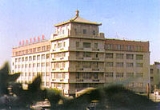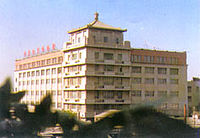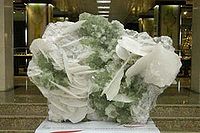
Geological Museum of China
Encyclopedia


Geology
Geology is the science comprising the study of solid Earth, the rocks of which it is composed, and the processes by which it evolves. Geology gives insight into the history of the Earth, as it provides the primary evidence for plate tectonics, the evolutionary history of life, and past climates...
museum
Museum
A museum is an institution that cares for a collection of artifacts and other objects of scientific, artistic, cultural, or historical importance and makes them available for public viewing through exhibits that may be permanent or temporary. Most large museums are located in major cities...
, boasting 200 thousand specimens.
This museum is located in the Xisi area of Beijing
Beijing
Beijing , also known as Peking , is the capital of the People's Republic of China and one of the most populous cities in the world, with a population of 19,612,368 as of 2010. The city is the country's political, cultural, and educational center, and home to the headquarters for most of China's...
and opened on October 1, 1959. It is the earliest geological scientific museum of China.
At present, the Geological Museum of China has more than 100,000 geological specimens. Many of them are precious items reputed as "National Treasures", such as "the Giant Shandong Dinosaur" fossil
Fossil
Fossils are the preserved remains or traces of animals , plants, and other organisms from the remote past...
, the highest and most complete dinosaur fossils extant in the world; the fossils of primitive birds that were found in the west of Liaoning Province, which has the essential values to the research on birds of the area; the teeth fossils of Yunnan Yuanmou Man, which shifts the appearance of human beings in China to a much more earlier time; the stoneware, stone pearls, bone needles and bone decoration unearthed from the site of the Upper Cave man at Zhoukoudian
Zhoukoudian
Zhoukoudian or Choukoutien is a cave system in Beijing, China. It has yielded many archaeological discoveries, including one of the first specimens of Homo erectus, dubbed Peking Man, and a fine assemblage of bones of the gigantic hyena Pachycrocuta brevirostris...
in Beijing; a cinnabar crystal of 237 grams that is called as "King of Cinnabar"; and more than 60 new mineral
Mineral
A mineral is a naturally occurring solid chemical substance formed through biogeochemical processes, having characteristic chemical composition, highly ordered atomic structure, and specific physical properties. By comparison, a rock is an aggregate of minerals and/or mineraloids and does not...
products that were found in China, and so on.
Basic displays of the museum are composed of five exhibition halls, namely, the exhibition halls of geological resource, global history, stratum paleontology, mineral rocks and diamond, with an exhibition area of 2,500 square meters.
The hall of geological resource introduces in different catalogues and classifications the abundant mineral products and other geological resources in China; the hall of global history introduces earth formation and construction, earth inner motive power geological action, earth outer power geological action and earth washing action; in the stratum paleontology hall, there are the special exhibitions of Zhendan biome, insect fossils, fish fossils, egg fossils, and the Upper Cave Man -- ancient creatures and their characteristics of different geological eras.

